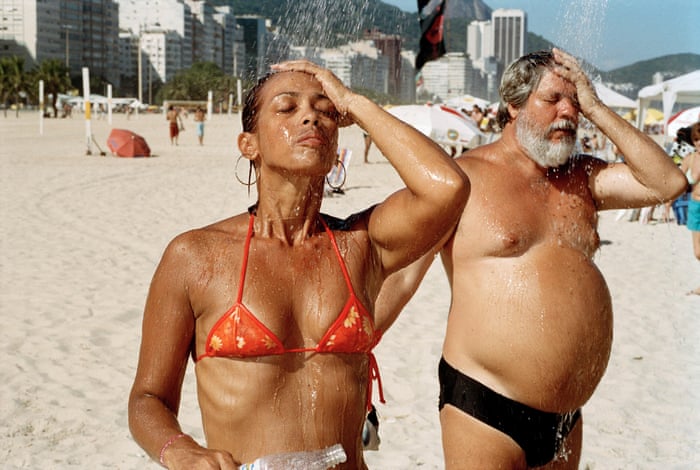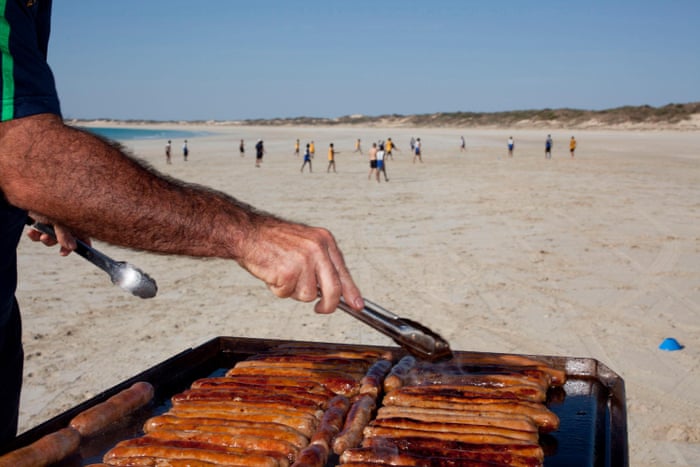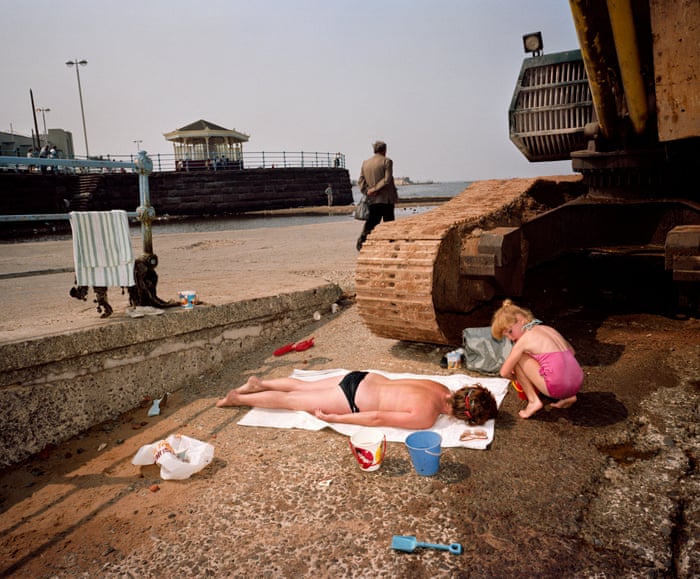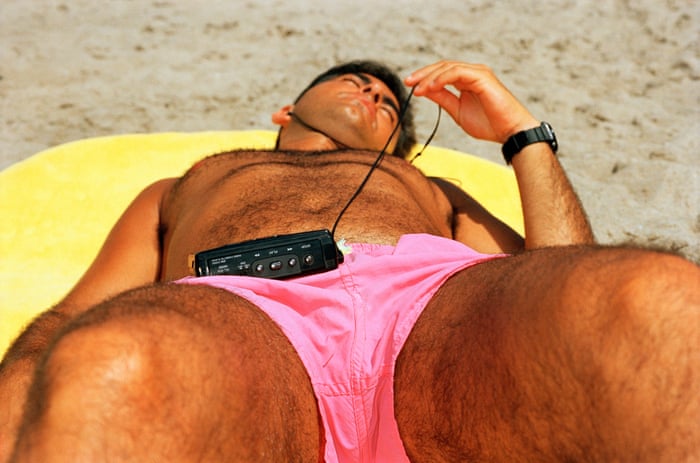ALL AUSTRALIAN CLICHES ARE TRUE : MARTIN PARR TALKS BEACH LIFE BEFORE BONDI SHOW.
Martin Parr answers my questions in explosive bursts – pop, pop, pop – like a flashgun being fired straight into my face. His clipped, coruscating replies are often loaded with wit and colour.
It’s somewhat blinding at first; blinding and yet entirely apt. Parr has built his reputation on punchy, super-saturated images that simultaneously expose and delight in the absurd comedy of everyday life, and his use of fill-flash to illuminate his subjects has long been a defining characteristic of his aesthetic. I feel as though I’m one of his subjects.
I’m talking to Parr ahead of an exhibition, Life’s a Beach, which opens in Sydney’s Bondi Pavilion Gallery on 31 January, showcasing a body of his work more than 30 years in the making. The images were shot at coastlines around the world, including a couple of frames taken in Australia, and reflect his endless “obsession” with beach culture and its leitmotifs.
Asked why he finds the beach so compelling, Parr recoils as if I’m bonkers: “It’s a no-brainer! The beach is where you can be yourself and you get lots of people who haven’t got many clothes on and it’s interesting and there’s all kinds of habits going on,” he says. Indeed, Parr is a master anthropologist.
For those who aren’t familiar with his work, the 63-year-old came to prominence in the mid-1980s for a book of images, The Last Resort, which he made over successive summers in New Brighton – a small, working-class seaside resort in Merseyside, England. He captured scenes of ordinary holiday life which positively outraged photography critics, such was the perceived indignity and mockery within them. There were unaccompanied children with their faces slathered in ice cream, people sunbathing on concrete beside industrial machinery, babies wailing in the sun, bins overflowing with fish and chip papers, and stone-faced pensioners silently living out their days in the supposed misery of it all
Parr was lambasted. His work was dismissed as patronising and as an “acerbic vision of hopelessness”. Only, it wasn’t.
His genuine affection for his subject matter took time to be acknowledged but he is now widely considered one of the finest, most trenchant photographers of our time – a photographer who highlights the brilliance within the mundane and who effectively says: ‘We’re all a bit mad, and that’s fine by me.’ As the critic Gerry Badger put it: “He has the essential pessimism of the satirist – but is also playful and whimsical”.
A couple of the images from The Last Resort, which in 2008 the Guardian ranked among the 1000 artworks to see before you die, are included in the forthcoming show at Bondi. They are joined by photographs Parr has shot in countries around the world – Latvia, India, Japan, Slovenia and Brazil among them – providing a peculiar and revealing tapestry of beach life.
Parr has spent relatively little time photographing in Australia, his most significant trip being to Western Australia in 2012 when he shot the series No Worries. He was excited by what he found.
“All Australian cliches are true!” he says. “You go down to the beach, people are cracking the beers, they’ve got the barbie on. It was like walking into a cliche. That’s why I liked it: because I like cliches.
“Sadly I’ve not done the classic Bondi stuff. The only bit I’ve done really is WA when I was commissioned by FotoFreo [a now defunct photo festival based in Fremantle] and we went to Broome. The beach wasn’t an integral part of what I was shooting, but I wanted to sew in a few pictures. But clearly it’s a subject I should come back to and do it properly.”
I tell him I find it odd that he hasn’t explored one of the great beach-loving countries of the world more thoroughly and am met with a typically droll reply: “Australia for me is a long, long way. There couldn’t be anywhere further.”
The suggestion that Broome might have been a tricky spot at which to shoot, given that Parr specialises in densely packed environments, brings similar mirth: “It was tricky insofar as obviously the more people you have, the easier it is to take photos of people: it’s very simple maths."
Perhaps this explains why the two beach images from Broome – one of sausages sizzling on a barbecue and the other of topless old men – seem a little lifeless, a little barren, in comparison to his usual work. Certainly I find their inclusion in the show rather jarring and would dispute Parr’s assertion that he selected only his “best” beach photos; in my eyes, these photos lack the engaging humour, the compositional quirks and the shrewdness of timing of his most vaunted shots.
Or perhaps I’m missing something? One can become so close to a subject matter or way of life that you become blind to its idiosyncracies and perversions. Maybe there are people in other countries who view these images and think: ‘My god, Australians fry sausages on the beach?!’ After all, The Last Resort hardly made a ripple when seen at Open Eye in Liverpool (near New Brighton); it was “outsiders” who scoffed or took umbrage.
Parr isn’t immune to self-criticism: “I like the fact that we have so many crap photographs in the world. I take a lot of crap ones as well. Out of all the photographers you’ve spoken to, I’ve probably taken more crap pictures than anyone. That’s just a fact of life.”
Either way, Life’s a Beach bristles with memorable images, and it is testament to Parr’s ongoing love affair with this subject that he continues to find such gems as the Sachin Tendulkar cardboard cutout on a beach in Chennai, India, or the portly man showering in Rio de Janeiro, Brazil, whose posture perfectly mirrors the woman beside him.

After 30 years documenting beach life (not that this is Parr’s only obsession: his wonderful series Autoportrait is similarly revisited time and again), Parr tells me little has changed about the coastal worlds he inhabits.
“The beach is pretty constant,” he says. “The only thing that’s changed is that you get accused of being a paedophile these days if you’re going around with a camera.”
Except, everything has changed. People’s usage and understanding of photography has changed, and their self-awareness has grown too. Parr agrees that the world is now a vainer place, but vanity certainly doesn’t inhibit his roaming lens. He’s adroit enough to unpick the reality from the facade, and to see what makes us human. The last line in Badger’s foreword to the 2010 reprint of The Last Resort sums it up perfectly: “He has a way of looking at the world that is clinically detached, sceptical to a degree, sharply humorous, yet humanistically engaged.”
I tell Parr I remember fondly a piece he wrote for the Guardian in 2010 about how to take better holiday photos. “The instinct is to capture people only when they are smiling around a birthday cake or at a wedding, but never during an argument or funeral,” he wrote. “On holiday, of course photograph the daytrips and good times, but make sure you document when everything isn’t going to plan as well.”
I ask if he has a tip specifically for taking better beach photos and his answer is typically piquant: “Don’t just photograph your own family, photograph anyone and everything. Hows about that? Then we’ll all get into trouble and they can sue the Guardian.”



Tidak ada komentar:
Posting Komentar